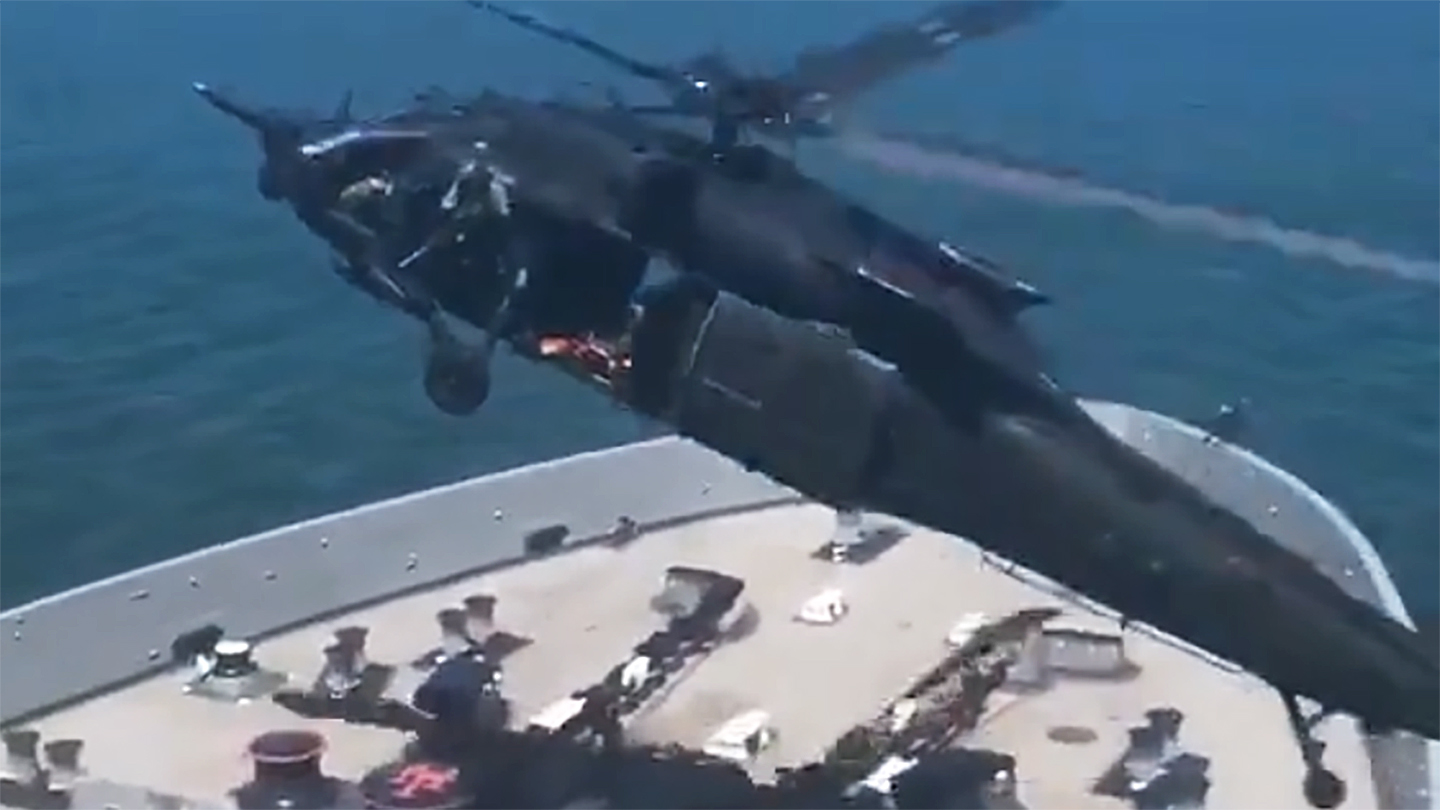Pilots of the U.S. Army’s elite 160th Special Operation Aviation Regiment (SOAR), also known as the ‘Night Stalkers,’ are well known for their flying expertise in challenging circumstances. Now, video has emerged showcasing how their skills, as well as their MH-60M Black Hawks, can be leveraged to sneak up on ships in order to conduct the rapid insertion of special operators onto their decks.
The footage in question was captured via a hand-held device from the vantage point of an observer aboard the San Antonio class amphibious transport dock USS New York. Details on where and when the video was captured remain unclear. As The War Zone has noted in the past, the 160th SOAR has a well established history of conducting maritime training exercises, and operations, with U.S. Navy assets and units.
Flying very low and fast above the water, we see one of the 160th’s Black Hawks passing New York’s starboard side in the footage. The helicopter executes a remarkable pop-up braking maneuver before coming to a rock steady hover over the moving warship’s bow. The black helicopter hovers there, simulating the insertion of troops via fast rope and/or raking the bridge with machine gun fire, before flying off.
In order to get an expert take on what we are seeing, we reached out to Chris “Ox” Harmer, a War Zone contributor and Sea Hawk pilot with thousands of hours in the type, including experience with real-world operations just like this.
“This looks like a great day for some shipboard familiarization flying,” he said. “You can tell by the lack of whitecaps on the water that there is very little wind, no more than eight knots at most, probably less.”
“The aircraft is flying pretty low – clearly no more than 50′ AGL (above ground level) – that helps minimize detection.”
“As the MH-60 approaches from stern to bow, flying on the starboard side, the pilot needs to bleed off excess airspeed to get into a hover. You can tell this pilot is an experienced stick – three maneuvers blend seamlessly into one.”

“First, forward speed is reduced by pitching the nose up while simultaneously dropping power; this bleeds the kinetic energy off the airframe. It’s a modified version of what we commonly refer to as a ‘quick stop.’ The nose up quick stop maneuver is used just to bleed off airspeed. It’s the most efficient, quick way to do it. You can tell by the gradual, progressive nose up maneuver that the pilot timed the control inputs correctly. As airspeed bleeds off, the pilot then tilts left wing down, with a bit of left rudder pressure to turn the Blackhawk 90 degrees to the left.”
“Having bled off airspeed to match the forward movement of the ship, the helicopter then goes a bit nose down to move into the correct hovering position over the centerline of the ship, followed by an immediate nose up maneuver to stop relative motion.”

“The final maneuver, which is very difficult to see, is a slight right wing down input to match the ships movement through the water. The pilot makes it looks smooth, easy, controlled, and professional. Well done!”
Of course, performing highly-skilled flying maneuvers, often at speed and amid adverse weather conditions and at night, remains very much the bread and butter of 160th SOAR pilots.
The regiment is well known for its frequent and elaborate training exercises, often involving fast-rope insertions from hovering helicopters. 160th SOAR regularly conducts so-called realistic urban training (RUT), for example, in order to best simulate the dense urban sprawl they would encounter should they be deployed to highly populated areas. As The War Zone has noted in the past, realistic urban training is critical for 160th aircrews and the special operators they cart around to sharpen their skills; simulating future battles in ‘megacities.’

However, being able to insert rapidly and extract quickly in other environments, such as at sea, is also a part of the unit’s remit. Doing so sneakily — providing target vessels with as little warning time as possible that an infiltration and/or extraction may be imminent, brings distinct advantages. This would be useful for a huge range of scenarios, from counter-piracy operations to maritime hostage rescue situations and interdiction of illicit cargo, where lives depend on how covertly and speedily maneuvers are conducted. It should be noted that a 160th SOAR MH-60M recently seen sporting blue camouflage could well be designed to provide greater cover during sensitive maritime operations like these. It also serves as a reflection on the growing importance on maritime operations, and the focus on training for them, as the possibility of a war in the Pacific looms larger.

So there you have it, another incredible display of skill from the 160th SOAR.
Thomas Newdick and Joesph Trevithick contributed to this article.
Contact the author: oliver@thewarzone.com
